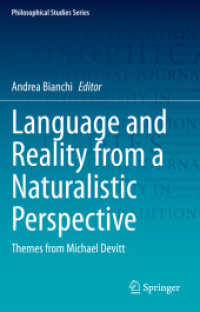- ホーム
- > 洋書
- > 英文書
- > Performing Arts
Full Description
The image of the dramaturg resembling a stuffy librarian, as opposed to the largely intuitive process of theatre making, belongs to the past. Contemporary theatre performances not only tell a story, but constantly reflect on the world in which that story takes place and is shown. As a result, dramaturgy has become part of the artistic process. Thus everybody involved in a theatre production is concerned with dramaturgical thinking, i.e. how to relate to material, process, audience and society. The dramaturg crosses borders between theory and practice, between theatre makers, performance and audience.
'Dramaturgy. An Introduction' provides a broad overview of the concept of dramaturgy and the profession of the dramaturg. It is intended for students and teachers of theatre and performance studies, but also for directors, scenographers, actors and for all lovers of theatre.
Contents
Introduction
1. What is dramaturgy?
1.1 Dramaturgy with and without a dramaturg
1.2 The roots of today's dramaturgy: From Poetics to postdramatic theatre
1.3 Theatre as a process of transformation
1.4 Dramaturgy in the Netherlands and Flanders
1.5 Perspectives on dramaturgy
1.6 Dramaturgy and theatre research
1.7 Dramaturgy within and across disciplines, styles, and genres
2. Material
2.1 Text as material
2.2 Aristotle: Language as medium of imitation (mimesis)
2.3 Theatre landscape until the eighteenth century
2.4 Absolute drama
2.5 Concepts of drama analysis
Primary text / Secondary text
Story & plot
Dramatic characters
Monologue
Re-definitions of processes of meaning production
2.6 Brecht: Epic theatre
2.7 Metatheatricality
2.8 Theatre of the Absurd
2.9 Textual montage techniques
Accumulation as a principle of montage
Juxtaposition as a principle of montage
Dissipation as a principle of montage
2.10 Material and materiality
2.11 Theatre as a means of exploration
3. Process: From material to performance
3.1 The material and the envisioned performance
3.2 Translational processes in theatre
Context - location
Context - time
Translation for accessibility
Starting point: The source
Relevance and inspiration
Research and interpretation
3.3 Visual aspects of dramaturgy
Scenography
The space and the audience
Writing the space
Light
The visual experience
3.4 Auditory aspects of dramaturgy
Voice
A few historical examples of voice in theatre
Beyond meaning
Accents, dialect, play with language, and sound of voice
4. Audience
4.1 The first spectator
4.2 The position and the role of the audience in the performance: the spectator as/is dramaturg
The dramaturg as intermediary between performance and audience
4.3 Audience reach
4.4 Theatre and politics: The heritage of Brecht and Boal
4.5 The auditorium and the stage
Site-specific and immersive theatre
4.6 Youth in/and theatre
Dutch Theatre for Young Audiences
Theatre education for children and youngsters
The last spectator
Epilogue
Glossary
Notes
Illustration acknowledgements
Bibliography
Index








